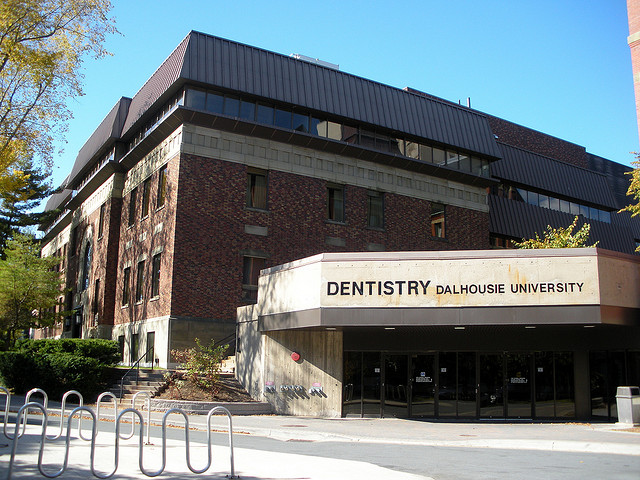rabble is expanding our Parliamentary Bureau and we need your help! Support us on Patreon today!
What do you think of when you hear the phrase, “Dalhousie Dentistry?”
Do you think of the scenic east coast university and the promise of up-and-coming dentists — or, do you think of the sexist Facebook group that launched the campus into a public relations crisis for much of the last year?
Odds are, you’re still thinking of the latter option. Though it’s been a year since the “Class of DDS 2015 Gentlemen” Facebook group was first brought to the attention of school administration, the story remains a damning mark on the school’s record –- and not one that’s likely to disappear quickly.
It began one year ago on December 6, 2014 — the 25th anniversary of the Montreal Massacre. A fourth year dentistry student posted a question about his female classmates to the group, asking “Who would you hate fuck?”
Thus kicked off the greatest scandal the university had ever seen.
Other universities should take note of the proceedings. Now a year past, we collectively — as students, administrators, and faculty — have a duty to learn and to improve. This is doubly important as we head into 2016 — after all, while Dalhousie may have received the brunt of the media’s attention, a great many schools have spent the past year embroiled in their own instances of racism, sexism, and homophobia.
On the Dalhousie Gentlemen Facebook group, these elements were laid bare in a series of comments, some of which seemed to fantasize the rape of female classmates.
“Penis,” one individual commented, “is defined as ‘the tool used to wean and convert lesbians and virgins into useful, productive members of society.'” Another added, “And by productive I’m assuming you mean it inspires them to become chefs, housekeepers, babysitters, etc.”
A task force has since determined that misogyny, sexism, racism, and homophobia were rampant in the school of dentistry. Seemingly a rallying point for students, problematic sentiments were even publicly displayed on a well-known graffiti wall in the student lounge, termed “the Cavity.” Though the school received numerous requests for its removal, the Cavity remained a prominent installation until the height of the scandal, when it was finally painted over.
The Cavity serves as a useful metaphor. If Dalhousie wasn’t willing to paint over a wall, how could it hope to paint over the numerous instances of online harassment that quickly became public knowledge?
In short, it couldn’t.
“There is distrust and suspicion about the University’s response to reports of discrimination,” the task force report reads. “‘Swept under the rug’ was a phrase we heard over and over again. The Faculty of Dentistry has no formal complaints process, and most people seem afraid to complain informally for fear of retaliation. They had little confidence that anything would be done anyway.”
It took a month for the school to suspend 13 students who participated in the group.
In the meantime, the woman who first brought the issue to the administration was ostracized by her peers. Her concerns and those of her parents were poorly handled by the administration. The harassment only became more pronounced as the story gained widespread media attention.
The media flurry in December could best be described as a firestorm of criticism. According to the task force report, an online petition to expel the students picked up over forty thousand signatures within a week. A #dalhateswomen Twitter campaign amassed more than 60,000 tweets, and Dalhousie’s communications department was receiving 40 media requests a day. At one point, a crowd of 200 rallied in front of the dentistry building waving signs with “#DalhousieHatesWomen,” “Expel Rape Culture,” and “We Want Names.” By December 28th, over 45,000 people had supported a petition demanding a transparent and independent investigation.
Much of this furor is now behind us. An investigation occurred, a (notedly imperfect) process of restorative justice was undertaken, and the involved dentistry students have all since graduated, though the report notes that, “with licensing bodies reviewing their applications very closely, their professional future remains uncertain.” Additionally, Dalhousie will likely suffer from decreased donations and a poor reputation for years to come.
Though in the eyes of the media the Dalhousie story has come to an end, the broader issues of sexism, racism, and homophobia on campus remain in play. Dalhousie is not alone. The University of Ottawa men’s hockey team has been embroiled in scandal since 2014, following allegations that multiple players were involved in a sexual assault in Thunder Bay. Saint Mary’s University still suffers reputational damage from a 2013 frosh week chant that glorified non-consensual sex with underage girls. It was sung by more than 400 students, including the student union president at the time.
We are not finished with these issues. As task force report says, “Universities, and everyone associated with them, live within a wider culture that increasingly glorifies sexual violence and exploitation. Soon after the story broke, Facebook posts at other universities quietly disappeared. Their faculties heaved sighs of relief that the scandal had not erupted in their backyards.”
Unless broader, more comprehensive action is taken on Canadian campuses, it will only be a matter of time until another “Dalhousie Gentlemen” comes to light.
This year was in many ways a year of scandal. Perhaps, we can hope 2016 will become the year of change.
rabble is expanding our Parliamentary Bureau and we need your help! Support us on Patreon today!



